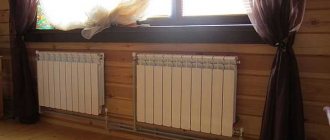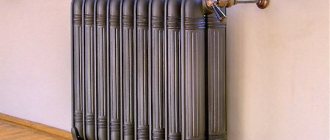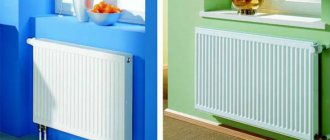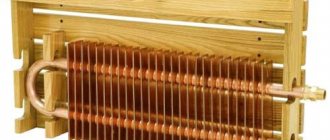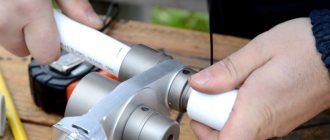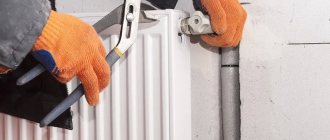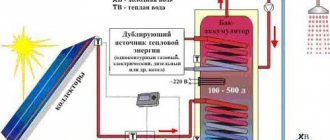In winter, the warmth in the apartment directly depends on the work of utilities. If even in severe cold the radiators in the house are barely warm, it makes sense to take heating of living spaces into your own hands. To do this, you can install a special heating element for a heating battery with a built-in thermostat. Installation of this device is simple, but it is better to take care of it before the start of the heating season. Let's figure it out in order.
Selecting a heating element
When choosing a heating element, you need to pay attention to some details.
Only in this case can you count on a successful purchase, high-quality heating, long service life and compatibility of the selected model with the water heating tank. boiler or heating battery boiler or heating battery.
Shape and size
There are dozens of heating element models available for buyers to choose from. They have different shapes - straight, round, figure-eight or ear-shaped, double, triple and many others. When purchasing, you should focus on the use of the heater. For installation in sections of heating radiators, narrow and straight models are used, since there is quite little space inside
When assembling a storage water heater, you should pay attention to the volume and shape of the tank, and based on this, choose a suitable heating element. In principle, almost any model will fit here. If you need to replace a heating element in an existing water heater, you need to purchase an identical model - only in this case can you count on it fitting into the tank itself
If you need to replace a heating element in an existing water heater, you need to purchase an identical model - only in this case can you count on the fact that it will fit into the tank itself.
Power
If not everything, then a lot depends on power. For example, this could be the heating rate. If you are assembling a small-volume water heater, the recommended power will be 1.5 kW. The same heating element will be able to heat disproportionately large volumes, but it will do this for a very long time - with a power of 2 kW, heating 100-150 liters of water can take 3.5 - 4 hours (not to a boil, but on average by 40 degrees).
If you equip a water heater or water tank with a powerful 5-7 kW heating element, the water will heat up very quickly. But another problem will arise - the house electrical network will not withstand it. When the power of the connected equipment is above 2 kW, it is necessary to lay a separate line from the electrical panel.
Protection against corrosion and scale
When choosing heating elements for heating water with a thermostat, we recommend paying attention to modern models equipped with scale protection. Recently, models with enamel coating have begun to appear on the market. It is this that protects heaters from salt deposits.
The warranty on such heating elements is 15 years. If you don’t find similar models in the store, then we recommend purchasing electric heaters made of stainless steel - they are more durable and reliable
It is this that protects the heaters from salt deposits. The warranty on such heating elements is 15 years. If you don’t find similar models in the store, then we recommend purchasing stainless steel electric heaters - they are more durable and reliable.
The presence of a thermostat
If you are assembling or repairing a boiler or want to equip a heating element with a heating element, choose a model with a built-in thermostat. It will save on electricity by turning on only when the water temperature drops below a set point. If there is no regulator, you will have to monitor the temperature yourself by turning the heating on or off - this is inconvenient, uneconomical and unsafe.
Types of heating elements for radiators
Despite the structural simplicity, various options for heating elements for radiators are presented on the shelves of specialized retail outlets and online stores. They differ in body design, materials of manufacture, power, and other features.
How to install heating elements in a battery, let’s compare heating elements. Homemade electric heating without pipes.
How heating elements for radiators differ:
- By power. Low-power models are designed for 0.3 kW. Devices up to 4 kW belong to the household category, from 4 to 6 kW - to the industrial category.
- Constructively. Manufacturers produce heating elements with right and left threads, single and double. The latter are considered more convenient to use. They increase the heating rate of the coolant, but are more expensive.
- Diameters. It depends on the cross-section of the radiator plugs on which the devices are mounted. The standard value is 40 mm.
- Additional options. The manufacturer offers 2 functions: Turbo heating. This is a mode that allows you to rapidly increase the temperature of the coolant to quickly heat the room. If this function is available, the device is equipped with a thermostat that allows you to change the room heating modes.
- Antifreeze. A mode that prevents system breakdown (defrosting) when temperatures drop. Heating elements with this function automatically maintain the minimum temperature due to economical energy consumption.
Also, heating elements for radiators may differ in length and have different design characteristics, which are not decisive for obtaining the result.
Rules for operation and maintenance of heating heating elements
For long-term and uninterrupted operation of the electric heater installed in the heating device, the following rules must be observed:
- Turn on the heating element only in a liquid medium. If there is no water or oil in the battery, the device will burn out. If liquid gets on a previously heated tube, a thermal explosion will occur. As a result, not only the heater, but also the entire battery may be damaged.
- Scale that forms on the surface of the tube must be removed periodically. This is done once every 3 months. If the scale thickness is more than 2 mm, the heat transfer will decrease, and the unit itself can quickly fail.
- To protect against voltage surges, the electric heater is connected via a UPS or stabilizer. Heating equipment must be grounded.
It is better to use distilled water as a coolant. Since it is impossible to comply with this rule in a house with centralized heating, you need to clean the pipes as often as possible from the resulting scale.
Advantages and disadvantages of radiator heating elements
Tubular electric heaters allow you to organize a practical and highly efficient heating system - main or additional. Before buying the necessary equipment, it is useful to evaluate all its advantages and disadvantages.
Pros:
- Simple installation - even an inexperienced technician can handle it.
- Low price of the heating element (not counting other equipment).
- Much more reliable than oil radiators. Batteries with heating elements are subject to repair. When the equipment fails, it is enough to replace the heating element.
- There is additional functionality.
- Automatic control of the heating system is possible - however, for this you will have to purchase additional appropriate equipment.
Minuses:
- High operating costs - this disadvantage is due to high electricity tariffs.
- Automation comes at a cost. If you buy a heating element with automation, the price of this kit will cost much more than an electric convector.
- They are inferior to oil radiators and convectors in terms of comfort due to lack of mobility.
- Heating elements are electrical appliances, and therefore generators of electromagnetic fields. The harmful effects of the device have not been proven. But field generation is a negative fact, given the proximity of the installation of radiators to the location of people. Due to the high speed of fluid movement, the device is inferior in efficiency to conventional systems with liquid coolants.
Costs will decrease if you switch the heating system control to automatic mode. Thanks to automation, heating elements will start working only after the temperature drops to a certain level. When the coolant heats up to the set value, the device will automatically turn off.
Types of heating elements for heating
Tubular-type electric heaters are distinguished according to several parameters:
- By type of working medium: gas (or air) and water;
- By type of heating surface: strip, rod, finned, and, the most common, tubular;
- By method of use: they produce heating elements for heating boilers, boilers, ovens, electric stoves, radiators, washing machines, etc.;
- By power per unit of surface (nominal and maximum): there are models on sale from 15 W to 15 kW per unit;
- For additional options; the presence of thermostats and automatic shutdown sensors in case of overheating.
For each specific case, you can select a heating element of the appropriate power and model that is optimally suited for operating conditions.
Why is a heating element needed in radiators?
The device heats the coolant in the batteries and maintains its operating temperature (what temperature of water in heating radiators is considered normal?). It can be installed not only in radiators, but also in any heating devices that have cavities filled with liquid. That is why the scope of application of radiator heating elements is very wide.
The device is used mainly in small areas - garages, utility rooms, etc.
A heating element is a metal tube with a heat-conducting electrical insulator and a conductive thread.
Features of radiators equipped with a built-in heating element:
- In appearance, they are almost no different from ordinary batteries. But, unlike the latter, they are not connected to the heating system.
- The devices are filled with coolant circulating through the battery.
- The best coolant is oil with low viscosity. This prevents the radiator from freezing when it is unplugged.
Replacement
After checking and determining the nature of the heating element malfunction, in which it is necessary to replace the part, you should begin to complete the task. The algorithm for its implementation consists of several successive steps.
- First of all, you need to disconnect the device from electricity.
- Next, you need to drain all the water that is in the container.
- Then you should remove the water heater from its mounts to ensure the most comfortable conditions for repair work.
- To gain access to the heating element, which is located inside the boiler, you need to unscrew the fastening of the bottom bar of the device. Before you dismantle anything, it's best to take a photo of the original wiring location. This will make assembly easier after replacing a failed part.
- The next step is to disconnect all existing wires that lead to the heating element.
- After this, the part can be removed from the container.
- In some cases, after cleaning the tubular part from plaque (if the body is intact), you can try to install the cleaned element back. Often such manipulations help restore the operation of the device.
- If the described method does not bring results, it is necessary to install a new heating element.
- After this, you need to reassemble the tank body in the reverse order.
Power calculations
To choose the optimal heating element for a cast iron battery, you will have to make some calculations.
- The power of the device is determined by the amount of heat that the room needs. So, to heat 1 m2 you will need 100 W, which means that for a room of 20 m2 you need 2000 W. Since cast iron batteries are used as heaters, the required amount of heat must be divided by the thermal power of one section of the battery, for example, 180 W. It turns out that this room will require 11 cast iron sections. The length of the heating element and its power must correspond to the size and needs of the radiator.
- Another parameter that should be calculated is the volume of coolant in the structure. This is important, since even a powerful device will not be effective if there is not enough liquid in the battery. Therefore, when purchasing a heating element, it is so important to consider what type of battery it is needed for. The volume of aluminum radiators is only 0.2 l, while in a cast iron battery it can be from 0.6 to 1.5 l, depending on the model and manufacturer.
Approximately 1 kW of heating element power per 15 liters of coolant is taken. Based on this and taking into account the number of radiator sections, it is easy to determine what power the device needs and how many of them should be in the heater.
Heat dissipation
According to factory parameters, such batteries (with a height or center distance of 500 mm), when integrated into a full-fledged hydraulic heating system, are capable of dissipating slightly less than 200 W of thermal power per section (180 W aluminum, 140 W cast iron).
However, in our case, do not expect such numbers. Firstly, the heat output of 180/140W is provided only by a new battery. And for such a heater, as a rule, used options are used.
Buying a new one for such a homemade product is not economically feasible.
Secondly, such work is only possible in the 90C-supply, 70C-return mode. In this assembly we use heating elements with an optimal operating temperature of 60-65C.
When it’s cold outside down to -25C, you can turn it up to +70-75C. The maximum possible temperature is + 80C.
Therefore, you will never heat such a battery to 90C in NORMAL operation. In principle, this is not necessary, since it entails the risk of a sharp increase in pressure.
Electric space heating
There is no need to install a pipeline when creating a heating system using heating elements. For each battery, it is necessary to select devices of varying power, depending on the purpose of the room.
Advantages of electric heating:
- Minimum labor costs during installation.
- Automatic water and air heating system.
The disadvantage of radiator electric heating is the high consumption of electricity and the purchase of materials.
Connecting the thermostat
Since thermostats can be used both to control heating elements and control the cooler, the device has two types of contacts and terminals. When connecting the device to the system yourself, you must strictly observe the polarity of the contacts and avoid contradictions in the circuit.
No electrical connection is required to connect a mechanical thermostat, since all control and opening of the switch is accomplished by physically changing the characteristics of the heating plate. To connect this device you need to follow the algorithm below:
- In the documentation for the devices there is a designation of the terminals by numbers; in accordance with these indicators, it is necessary to assemble the system. First of all, you need to connect the neutral cable to the electrodes of the box and take it directly to the consumed heating elements, for example, a heated floor;
- The phase is supplied to the controller directly, without connecting to household appliances. The box itself will distribute electricity when the contacts are turned on. In some devices, it is necessary to lay a jumper inside the thermostat from the positive wire to the operation indicator, which shows a signal at the moment the heater is turned on and throughout the entire period of operation;
- The control device contains terminals for connecting a cooling heating element, as well as for an external temperature sensor. All devices must be connected in series, and the current must be turned off completely. This is a typical connection diagram for a thermostat, which is most common in underfloor heating or infrared heating systems;
- The temperature sensor is connected last, after which a test run of the system is performed and the voltage on all elements is checked.
There is also a diagram for connecting a thermostat using a magnetic circuit breaker; most often, this scheme is used when there are several controlled devices that require high voltage current for operation. In this case, the machine is connected to an open network of the positive cable in parallel with the thermostat; in addition, there is a connecting cable with the control device. Current is supplied to consuming devices through a circuit breaker, but it is controlled by a thermostat. The heating elements are connected to the controller only on a parallel line and through an automatic machine, this allows the system to operate with high voltage without interruption and in a safe mode. In the event of an emergency, the switch will operate and completely de-energize all devices.
Thus, it is clear from the diagram that the thermostat is connected to heating or cooling devices immediately before voltage is applied to them, that is, the controller will be the first element in the system. Many thermostats are equipped with an electronic chip and processor, which, in addition to temperature indicators, provide additional data on various indicators, such as the state of humidity in the room, pressure and the time required to achieve the set parameters. Such devices have a much higher cost than mechanical thermostats for household use.
Criterias of choice
When selecting a heating element for a radiator, you should take into account its technical characteristics, as well as the parameters of the battery. The main factors influencing the choice of device are:
- Power. In rooms with good thermal insulation properties, heaters from 2 to 3 kilowatts can be installed. In older buildings, it is best to use heating elements with higher power.
- Length of the electric heating tube. It is recommended to purchase heating elements ten centimeters shorter than the battery. Correct selection of the length of the heating device allows you to evenly heat all sections of the radiator.
- Battery Type. In order for the heating element to optimally fit the radiator, you should carefully study its technical data sheet. It specifies which types of batteries the product should be used with.
- Automatic control. Not all models have this option. For ease of use, it is best to purchase heating elements with automation, which are equipped with a thermostat.
The heating element should be ten centimeters shorter than the radiator.
The diameter of the electric heater is also taken into account in accordance with the cross-section of the plug on the radiator. It is important to correctly determine the placement of the thread.
It is necessary to purchase only high-quality heating elements from trusted manufacturers. Before purchasing an electrical appliance, you should check its integrity and serviceability.
Preparing the tool
Before making any electric boiler, you need to take care of a good tool - this is perhaps the weakest point. It is not difficult to assemble the units themselves, but, for example, without a welding machine it is unrealistic.
It is not possible to assemble a good home electric boiler without a welding machine.
- Welding machine - it is better to take an inverter welder (price starts from 4,700 rubles);
- Cutter - you need to be able to work with a gas cutter, so for home use, take plasma models (price from 4,300 rubles);
- Grinder - it is advisable to have 2 grinders, a large one for a 230 mm disc (price from 2800 rubles) and a small one for a 125 mm disc (price from 1800 rubles);
- Electric drill;
- Calipers;
- Hammer;
- Kern;
- Roulette.
Cast iron electric heating radiators
The idea of autonomous heating, not tied to a pipeline system, based on electrical energy is most suitable for implementation in those houses where there is no gasification. In some places this has become very relevant lately. The master installed autonomous heating in his apartment using cast iron radiators with temperature control in each room. In this regard, energy is saved.
My total heated area is 68 sq.m. A battery of 11 sections is located in a room of 16 sq.m. The house is made of red brick, three sides border the street and are insulated with 50mm polystyrene foam, and one side borders the neighbors. The average temperature outside in winter is -10 -15 degrees. In winter, the average monthly electricity consumption, purely for heating use, is about 1750 kWh.
Discussion
zapilimne Remove the word “autonomous” from the name, it has nothing to do with it, unless you have your own power plant, of course. Electrical heating is the most expensive heating method. Do you know why central heating is used? Because at the thermal power plant there is a huge turbine that rotates with steam and, in addition to electricity, produces a huge amount of heat as exhaust, which turns out to be for nothing, and instead of simply throwing it into the atmosphere, they heat water and supply this water to houses for heating through batteries, Well, roughly speaking. And such projects are incomprehensible to me. Wherever it is possible, they are heated by central heating or gas, they are heated with electricity when there is no other way to heat the room.
REXXRS If the cast iron battery is hung at a slight angle towards the heat, the water circulation will be even better. The large volume of water in a cast iron battery is also an excellent heat accumulator. It will be difficult to achieve a stable temperature in the room with aluminum; the heater will constantly turn on and off. Why not put 2 tena on different ends, it won’t be cheaper than ordering a special one. ten?
BAU I gave it a like a long time ago when I first watched it and liked the idea. This summer I changed the heating pipes and decided to do the same: I installed one weak heating element in each living room. Minimum 1 kW maximum 1.5 kW. And now it’s October and the tests are underway. So, the Al battery showed more pleasant results: there is less water in it, and Al, as you know, has better thermal conductivity than cast iron and a lot of water. Accordingly, the air in the room heats up faster and it takes less energy than in the cast-iron (new) batteries that were replaced, the old ones overgrown with the same but new ones. Those. the system works quite efficiently overall, but... if the wiring and other conditions allow it, install heating elements 1.5-2 times more powerful than you planned, but do not exceed the total power! Then the room will warm up faster. I didn’t sculpt the air sensors, because... I have gas and heating pipes in place, I just heat the right radiators in the right rooms, and not all at once. For those who have a house >50-60m2 and only 220V, don’t count on anything special – there won’t be enough power to heat more than 2-3 rooms, the circuit breakers will break, or worse will happen. The author probably has an ordinary apartment with neighbors above and below and on the sides too, i.e. heat loss is minimal. In private houses, heat loss is significantly greater... Take this into account. It’s simply pointless to put 0.8 kW in such a huge battery as the author’s. I have 1 and 1.5 kW in cast iron and they are only 7 sections, but here there are more than 10. PS When purchasing, take heating elements, wire, plugs - all the most powerful and branded! And most importantly - take branded thermostats or ask for an exchange! I was offered China, Poland and Italy. I chose the average in price and quality - Poland. It seems OK, but... they click noisily and interfere with sleep at night (I would like it to be quieter. But overall, it’s tolerable.
Herald of the Financial Apocalypse It’s easier to install a combination boiler using electricity and solid fuel with oil in the system. There are no problems with defrosting the system, as with water. The little chock keeps you warm all night! Another 3 priest built this system in a house of 120 meters, six heated rooms, and no one has touched it since then. Self-made pyrolysis boiler. There is almost no smoky exhaust.
Lighthouse of Communism It was in vain to cut out the water heating pipes. The total electricity consumption of all radiators is more than the boiler consumption for the overall system. In addition, the pipes themselves provide additional heat, in addition to the radiators. I work on heating systems and am ready to say that it is more profitable to have a combined system (solid fuel + electric) than just electric. Apparently, the system was initially installed incorrectly, which is why there was a need for alterations. When the system is in good working order, combined heating is beneficial.
Kyrylo Hrechyn – Beacon of Communism I disagree! I have a 6 kW electric boiler. And the batteries are not hot and consume a lot! I installed 700 watt heaters in 5 rooms = 3500 watts + thermostats. The batteries are hot! Consumption is 60% less. The advantage is that there is no movement of water through the system. Heat is released immediately on the spot.
Roman Roslyakov – Beacon of Communism +kirill grechin Couldn’t stand it... And what exactly is the advantage? Of course it exists if you run pipes from battery to battery along the street. And there’s no need to talk about the fabulous 60%. It's funny to read by armchair specialists.
Vasya Vasov +Roman Roslyakov Correct me if I’m wrong: 1) “For example, to increase the temperature of water weighing 1 kg by 1 ° C, an amount of heat equal to 4200 J is required, and to heat the same mass of sunflower oil by 1 ° C the amount of heat required is 1700 J.” – Yes, maybe my friend exaggerated, but not by much. 2) What is the convenience? If something fails, then there will be no heat in a particular room. etc.
Thermostat is not working - how to check?
At the same time, do not expect any major changes when replacing a thermostat from one model to another. There is an opinion that if the warm floor does not heat up, then it is worth changing the thermostat to a more expensive one, everything will change by itself.
The air temperature in the room will immediately rise, and where it was previously cold, it will become hot. Roughly speaking, the thermostat is like the speedometer in your car.
You can draw 300-350 km/h on the speedometer, but if the engine is not capable of producing such power, then you will not see this speed. If something is to blame for the poor performance of heated floors, then first of all look at the temperature sensor.
Checking the functionality of the thermostat is very simple. Supply it with 220V power and connect the remote sensor.
Next, instead of a warm floor, connect a regular incandescent light bulb to the thermostat. You begin to unscrew the knob, changing the temperature.
At a certain moment the light should light up.
Next, hold the temperature sensor in your hand and wait. When heat comes from your body, a working thermostat will turn on and the light bulb will go out.
If the sensor is hidden deep in the screed, you can warm up the area with a hairdryer and wait for the same effect. When the lamp does not react at all, this indicates a malfunction of the device.
The fastest way to repair in this case is to transfer the work from the floor sensor to the air sensor built into the housing.
The ends of the cable on the device from the floor temperature source will have to be unscrewed, and the settings of the device itself will have to be reset.
All this will work correctly provided that the thermostat is installed directly in the heated room.
If you have an electronic thermostat with PWM control, then using the above test method, it is not recommended to heat the sensor too quickly with an extraneous heat source. What does this mean?
Firstly, the thermostat will immediately detect an abnormal increase in heat and work ahead of time. Secondly, the “smart brains” of the device will forcibly turn off the heating for the next 20 minutes.
In this case, after just 5 minutes the temperature on the device’s display will be sufficient to turn on, and startup and contact closure will not occur. As a result, you will have doubts about the correct operation of the thermostat.
Therefore, the fast heat test is ideal for mechanical devices, but be careful with electronic ones.
When are heaters needed?
As a rule, the device is purchased to create local autonomous heating or as an addition to a central heating system. If the latter is unstable, heating elements often become an “emergency” heater of the coolant inside the batteries.
If for some reason the central heating is turned off, using the heating element it will be possible to maintain the temperature in the house at the required level and avoid defrosting of the pipes.
Types and methods of manufacturing heating elements
Modern electric heating elements have high strength and the ability to change shape and size under the influence of high temperatures without compromising their technical characteristics. They are used not only in household heating appliances, but also in industrial ones. True, in the latter they install more powerful analogues with larger sizes. All modern heating elements have a high rate of long-term operation.
Manufacturers produce two types of heating elements, which differ in the manufacturing method. There are products that are mass produced, and there are also those that are produced in small batches. They usually meet specific customer requests. They are used in special heating installations with specific requirements. By the way, the price of the latter is much higher than the former.
Tubular electric heaters
This is the most common type of heating element, which is used in almost all electrically powered heating devices. With the help of tubular analogues, heating of the coolant occurs according to the principles of convection, radiation and thermal conductivity as a result of the conversion of electrical energy into thermal energy.
This heating element has the following characteristics:
- Tube diameter 6.0-18.5 millimeters.
- The length of the heating element is 20-600 centimeters.
- The tube can be made of steel, stainless steel or titanium (a very expensive device).
- Device configuration - no restrictions.
- Parameters (power, performance, etc.) - as agreed with the customer.
Finned tubular electric heaters
Used to heat air or gas that heats the room
TEHPs are the same tubular electric heater only with ribs that are located in planes perpendicular to the axis of the heating tube. Typically, the fins are made of metal strip and secured to the tube with special clamping nuts and washers. The heating element itself is made of either stainless steel or structural steel.
This type of electric heating devices is used to heat air or gas that heats a room. They are often used in heating devices such as air curtains and convectors - where heating with heated air is required.
Electric heater block
TENB are used only if it is necessary to increase the power of the electric heater. They are usually installed in devices in which the coolant is liquid or any bulk material.
A distinctive design feature of the heating element is its fastening to the heating device. It can be threaded or flanged. Particularly popular today is a block-type heating element with collapsible flanges. Such a heating element can be used repeatedly for different devices. The burnt heating element can be removed and a new one put in its place.
Cartridge-type electric heaters
This type is not used for heating systems.
This type is not used for heating systems. It is used as a mold part to create any products, since it is a part of industrial equipment. They are not found in everyday life, but it is necessary to mention them, because this type of heating element is included in the category “tubular electric heaters”.
A distinctive feature of this analogue is the shell, made of stainless steel, which is polished to the maximum. This is necessary so that the heating element can enter the mold with a minimum gap between the tube and the walls of the mold. The standard gap should not exceed 0.02 millimeters. This is how tightly it should fit.
Ring electric heaters
This type of heating elements is also used only in industrial installations. Their purpose is to heat injectors, nozzles of injection units and injection molding equipment.
Electric heaters with thermostat
Heating element with thermostat TECHNO 2 kW
This is the most common heating element today, which is used to heat liquids. It is installed in all household electrical appliances that are associated with heating water. The maximum temperature of the released heat is +80C.
It is made from nickel-chromium wire, which is filled inside the tube with a special compressed powder. The powder is magnesium oxide, which is a good insulator of electric current, but at the same time has a high thermal conductivity.
Installation of heating elements
There is nothing complicated about installing radiator heating elements, so any home craftsman can do it. To avoid any problems during installation, before purchasing, familiarize yourself with its packaging and check that everything is in place.
It is advisable that the box contains everything necessary for installation along with the heating element. If any parts are missing, you need to purchase them immediately. The installation of heating elements with thermostats is practically no different from the installation of analogues without automatic control.
Before installing the heating element into the radiator, make sure that the heating system is drained of water. That is why in apartment buildings it is better to install the device in the summer, when the central heating is turned off.
How to install the heating element:
- Remove the plug located at the bottom of the radiator.
- Install the heating element using a threaded fastener and a rubber gasket.
- Treat the joint with sealant.
Video of installation of radiator heating element:
Radiator with heating element. We do it ourselves.
Autonomous heating, heating element in the battery, in case of emergency heating shutdown
What to pay attention to:
- Place the heating element only in the lower part of the radiator - this will ensure unhindered coolant circulation.
- The device is inserted into the battery strictly parallel to the floor - this is necessary for unhindered operation.
- The coolant, when heated, increases the pressure in the battery. This requires the installation of a small expansion tank. You can also equip the radiator with a valve to regulate the pressure in the system.
- The heating element can only be connected through a grounded socket. It is also recommended to connect the device to a voltage stabilizer - this will protect it from power surges.
- The fasteners for connections of tubular electric heaters are quite fragile. In order not to damage it, installation must be done with the utmost care, without applying unnecessary force.
Technical characteristics of homemade heaters
In most cases, home-made heat generators are a copy of those devices that are commercially produced by official companies. They may be inferior in quality to the original in terms of technical characteristics, but for a number of reasons, apartment owners still want to assemble such a unit on their own.
The fact is that when making it yourself, the equipment is several times cheaper, since improvised means are used during assembly. It will also be possible to assemble the unit of the required size and dimensions, and independently select a housing with the desired strength. This means that the master chooses all the technical characteristics himself, based on the size of the room that needs to be heated. For example, if heating elements are used to assemble the apparatus, then only two samples will be suitable for heating one room. More than 4 heating elements per room are usually not used.
A DIY battery heater may violate operating conditions
But it should immediately be noted that a self-made heater may violate the operating conditions drawn up by official manufacturers. A homemade product is not as safe as a purchased unit. The heating device will be unpredictable and may result in unpleasant consequences for others. This is due to many factors:
- Homemade heating devices often cause fires.
- There are also no legitimate manufacturer warranties.
- The technical characteristics of a homemade device are uncertain, and if assembled inappropriately, the result will be an unaesthetic design.
But if all these shortcomings do not frighten the master, and there is no desire to purchase a heating device in a store, then you can proceed to assembling the heater yourself.
How not to make a mistake in choosing
Radiators for heating elements are quite simple to choose, since they do not require a special variety of designs and technical characteristics. Please consider the following points before purchasing.
Electric heating element power calculation
In order to correctly determine the required power of the device, it is advisable to know the thermal standards in force in the given area. As a last resort, you can use the average indicator, which can be used in central Russia and make some adjustments if necessary.
Based on this, for 10 sq. meters of heated area, provided that the heating element will be used as the main heating, 1 kW of its power is required.
If heating elements for radiators are chosen as the main heating for the home, it is highly advisable to purchase models with a thermostat. In this way, it will be possible to regulate the power of the device and thereby reduce energy costs
If the device is used as additional heating, the required power will be 3-4 times lower. In addition, when choosing a device, you should take into account the specifics of the radiator heating element.
Due to its design features, it will be able to operate uninterruptedly only at 75% of the heat transfer from the radiator. With higher power, the device will overheat and it will constantly turn off.
Based on this, the power of the device is calculated. The exact heat transfer values of a particular radiator can be found in its technical documentation. However, on average, one section of an aluminum battery has a heat output of 180 W, and a cast iron battery has a heat output of 140 W.
Let us calculate, as an example, which heating element is suitable for a 10-section radiator. We multiply the data by 10 and we get that for an aluminum battery it is worth taking a heating element with a power of up to 1.35 kW, for a cast iron battery - up to 1 kW.
Design features of the device
For each radiator, you should select a heating element that is suitable for it in size and thread direction. The equipment has different shaft lengths, which may affect its performance.
If the length of the heating element is insufficient, the equipment is not able to provide a sufficiently high circulation rate of the coolant, as a result of which the heating of the radiator will be uneven and insufficient.
The length of the device is perhaps one of its most important characteristics, which directly affects its efficiency. Before purchasing, you should measure the radiator and calculate the required length of the built-in heating element
The optimal option is when the heating element rod does not reach the inner wall of the opposite edge of the radiator by 60-100 mm. It is also important to choose the right body shape and diameter of the device.
The material of the plug may vary between models. To make the right choice, you should study the manufacturer’s recommendations, where he describes the types of heating devices suitable for using a particular heating element.
Availability of automatic control
Devices are available for sale with or without built-in automatic control. The first variation is as convenient as possible and does not require the purchase of additional equipment. In this case, a thermostat with a sensor that measures the temperature of the coolant is built into the lower part of the heating element housing.
If there is no built-in automation, the electrical appliance does not have a thermostat. In this case, it is advisable to connect using a detector that measures the air temperature in the room.
It must be admitted that this equipment is not so popular and in demand for large European companies to start producing it.
In stores you can find radiator heating elements made by Turkish, Polish and Ukrainian brands. In terms of quality and functionality, they are approximately similar.
It is difficult to say which company's products should be preferred. But you need to be wary of Chinese heating elements, since you can often get a low-quality product.
Additional information on choosing a heating element for heating is provided in this article.
Preventive measures for breakdowns of heating elements
summarize the power indicators
When the heating elements operate, the heating spiral gradually collapses. That is why heating elements produced for heating batteries must be selected with a maximum service life of 10 years. Also, as a preventative measure, follow these rules when operating heating elements:
- Do not pour tap water into pipes or heating radiators, as this may create scale on the surface of the heating element. Only distilled water should be used;
- It is imperative to install a residual current device, to which you can connect either one or several heating elements at once. If an accident occurs, it will quickly turn off the electricity, and no one and nothing in the apartment will be harmed;
- It is not recommended to frequently turn the device on or off when heating, this shortens its service life;
- if you observe static electricity on the battery, be sure to check the heating element for leaks;
- It is strictly forbidden to install heating elements in a boiler or radiator without grounding.
If you follow these simple rules, then your heating system in the apartment will not only work efficiently, but will also not pose any threat. It is also highly advisable to take care of the thermal insulation in the room before installing the heating element into the heating system. This will increase the service life of the device and will also allow you to save a lot on electricity.
Radiator heating element design
Structurally, the device differs little from other types of heating elements. Design Features:
- The body is made of metal pipe and transfers heat well. It is usually made of carbon steel or stainless steel. The latter option is chosen if the metal will be heated to temperatures above +45 °C.
- The steel tube—the body—is coated with chrome or nickel plated to protect against corrosion.
- The heating element is a nichrome spiral. This part heats up to high temperatures when an electric current passes. The spiral is located inside the housing, and the rest of the space is occupied by filler.
- The body is filled with quartz sand or periclase, and then pressure testing is carried out and the product is given the required shape.
A tube with a conductive spiral can be placed inside any radiator - copper, cast iron, bimetallic, etc. The power of the device is 2.5 kW. Industrial-type devices are more powerful - up to 6 kW.
The operation of a radiator heating element is extremely simple:
- Thanks to a well-thought-out design, all incoming electricity is converted into heat in the device, with virtually no losses.
- When turned on, the spiral heats up quickly, and the oil/water is heated from it.
- The heated liquid, in accordance with the law of physics, rises, and cold liquid comes in its place.
- The heated liquid, rising, gives off its heat and, cooling, sinks to the lower part of the radiator.
- An electrical appliance creates fluid movement inside the radiator.
The main danger of heating elements is limescale. It gradually covers the heating element, which sooner or later leads to failure.
One of the best coolant options is transformer oil. It heats up quickly and retains heat for a long time, gradually releasing it to the body.
How to choose an oil electric heater
When choosing a heater, you must pay attention to the technical characteristics of the device described in the operating instructions. You will need to pay attention to the radiator power, additional functions and other aspects
Determining the required heater power
The instructions indicate the efficiency of the heaters, and also provide power parameters. Some buyers face a certain problem. In the technical characteristics of European products, instead of the usual kW, kilocalories may be given. This calculation is accepted all over the world, so well-known manufacturers indicate the heater power in kcal.
How to calculate the required power of climate control equipment?
- Oil electric heaters produce 859 kcal/hour of heat per kW. Accordingly, a radiator with a capacity of 2 kW can produce about 1718 kcal every hour. By performing reverse calculations and converting kcal to kW, you can calculate the required power of the device.
- To maintain the room temperature and use it as additional heating, it will be enough to install a budget model with a performance of 50 W per m².
- If you plan to use the installation as the main source of heating, calculations are performed using the formula 100 W = 1 m². An oil-fired electric heater can heat an area of up to 20 m². To heat rooms with a larger area, it is more economical to choose infrared or electric convection heaters.
Choosing a heater based on additional functions
You must first decide what exactly is expected from the heating equipment. Functional features improve ease of use and provide additional protection.
What you should pay attention to?
- Heater device. The rate of heating of the room and the uniformity of heat distribution depend on the effective use of convection. Models with a built-in fan heater are best used in unheated rooms, as well as rooms with a large area, over 15 m².
- Protection system. Safety during operation is ensured by controllers and sensors. There is a float inside the housing that controls the presence of coolant. When the oil level in the heater decreases, as a result of a fall or loss of sealing of the housing, a shutdown signal is sent.
- Additional functions. The choice of an electric oil heating radiator is influenced by the presence of additional built-in devices. For example, some models have an air ionizer, others automatically maintain the necessary humidity in the room, and others are equipped with a special removable clothes dryer.
To heat a balcony, you should choose a heater that has an anti-freeze function. This will allow you to operate it even when the temperature drops below 10°C.
Can fires occur from an oil radiator?
Fires caused by oil-based electric heaters can occur solely due to improper use and faulty wiring.
- Violation of operating rules. The device must not be used to heat rooms with high humidity. It is forbidden to dry clothes without a special device, or to place things on top of the radiator. This is one of the most common causes of extreme heat and possible fire.
- Faulty wiring. A heater, especially one with overheat protection sensors, is completely safe. Fires are caused by faulty or inappropriate wiring. The operating principle is based on the closure of the heating element. In this case, a voltage of 1-2 kW is supplied to the heating element. If the supply wire is powered by at least one more device, a fire cannot be avoided. The heater is connected to a cable connected directly to the meter. For greater safety, automatic machines and RCDs are installed.
In the event of a thermostat malfunction, the surface temperature of the heaters rises to 150°C. The body of the equipment must be protected from children. The radiator should be installed away from the curtains of furniture.
Which is better, oil heater or electric?
In terms of their technical characteristics, oil heaters are inferior to electric convectors. Therefore, the former are not suitable for use as the main source of heating.
If we consider that without maintenance, oil heaters are sources of constant dust combustion and oxygen combustion, the inappropriateness of using the devices becomes clear. It is optimal to use heaters for heating dachas, country houses and unheated premises.
Types of heating elements
Tubular electrical appliances are divided into household (2.5-4 kW) and industrial (4-6 kW).
There are devices equipped with 2 spirals and other features:
- Antifreeze. The option prevents the system from freezing by constantly maintaining the temperature. This function does not require a lot of energy.
- Turbo heating. The option allows you to quickly heat the air using a thermostat.
Conclusions and useful video on the topic
Video about the difference between natural and forced circulation of coolant in a heating system:
Video clearly demonstrating the differences between different heating system schemes:
Scheme for effectively connecting heating batteries with a two-pipe system:
The heating efficiency directly depends on the choice of battery connection diagram for your home. With the right option, heat loss is minimized. This allows you to get maximum effect with the least amount of fuel used. You can install the batteries yourself
It is important to take into account the construction features so that cold radiators do not interfere with a comfortable life in a cozy home
If you are interested in the material we have proposed for consideration, have questions or a reason for discussion, we invite you to post comments.
How are heating elements used in heating radiators?
The main function of heating elements for radiators is to heat the liquid in heating systems, centralized or autonomous. The device can be used as a primary or secondary source.
Options for using radiator heating elements in heating systems:
- In temporary housing. In the off-season, while the heating has not yet started working, such radiators warm the residents. Radiator heating elements are convenient in country houses that have to be heated from time to time. In this case, heating elements are installed in radiators installed in each room. In rooms that do not have any other type of heating, heating elements in radiators are used autonomously as the only source of heat. In this case, it is recommended to fill the batteries with oil with a low viscosity level, since it has a low freezing point.
- In permanent housing. The batteries are filled with ordinary water (this is cheaper), since the system is not expected to freeze. But this option is expensive, since you have to constantly waste electricity. Heating elements in radiators can be installed in high-rise buildings if the main heating system does not provide comfort in the room. Installing these devices allows you to maintain optimal temperature in residential areas.
- Addition. This is the most rational and popular option. Heating elements are built into batteries and are turned on when the heating is turned off for one reason or another.
Installing radiator heating elements in multi-storey buildings is an unprofitable and impractical solution, since it involves limiting the access of water circulating through the heating system in the house. As a result, you have to pay twice - for the operation of the electric heating element and for the central heating.
Advantages of heating elements
Heating elements (heating elements) have many positive characteristics:
- economy and efficiency - when converting electricity into heat, there is practically no energy loss;
- simple installation - you can even install a heating element for a heating battery yourself and for this you do not need to obtain a special permit from various authorities. Each device is accompanied by detailed instructions from the manufacturer, explaining the connection procedure and operating rules;
- durability - it is achieved through chrome and nickel plating;
- compactness;
- safety;
- an electric heating element with a thermostat for capillary-type heating allows you to regulate the temperature with a high degree of accuracy;
- save energy consumption by allowing the device to operate in pulses;
- affordable price;
- availability of additional functions.
In addition to its positive qualities, a device such as a heating element for heating batteries has several disadvantages:
- high cost of electric heating of residential premises due to electricity prices;
- Not in all settlements throughout the country the electrical power from the substation allows the use of these devices.
Solid fuel heating boilers with heating elements
Currently, boilers operating only on solid fuel are rarely used. Instead, the domestic market offers a wide selection of combined and universal heating units that operate not only on solid fuel, but also on other types of energy carriers. A wide range of electric solid fuel heating boilers is offered to consumers.
This type of units is intended for heating residential, domestic, agricultural and other premises. A number of models can be used as both the main and backup sources of heat supply. They are also installed for use with other types of heating systems.
A heating element solid fuel boiler has the following advantages:
- the device is designed for cold winters, its efficiency is 65-75%;
- thanks to the presence of a grate system, wood waste and low-quality fuel with a humidity of even 70% are burned;
- Reliable insulation is used, consisting of a water jacket with high-quality thermal insulation materials plus a protective casing capable of withstanding more than 1300 degrees. Despite the high power, the surface temperature of the device does not pose a threat to humans at all;
- a reliable draft regulator allows you to easily set the heat power (pro


